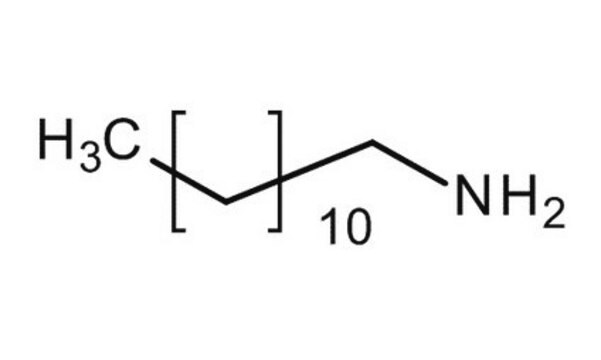H7408
esadecilammina
technical grade, 90%
Sinonimo/i:
1-aminoesadecano, Cetilammina, HAD
About This Item
Prodotti consigliati
Grado
technical grade
Livello qualitativo
Tensione di vapore
<1 mmHg ( 20 °C)
Saggio
90%
P. eboll.
330 °C (lit.)
Punto di fusione
43-45 °C (lit.)
Stringa SMILE
CCCCCCCCCCCCCCCCN
InChI
1S/C16H35N/c1-2-3-4-5-6-7-8-9-10-11-12-13-14-15-16-17/h2-17H2,1H3
FJLUATLTXUNBOT-UHFFFAOYSA-N
Cerchi prodotti simili? Visita Guida al confronto tra prodotti
Categorie correlate
Descrizione generale
Applicazioni
- Interfacial structuring of liquids: Hexadecylamine is explored for its role in the solvent-assisted interfacial association of oppositely charged polyelectrolytes and amphiphiles, offering potential advancements in the structuring of liquids for various industrial and scientific applications (Bak et al., 2023).
- Efficient light-to-thermal conversion: Additionally, hexadecylamine is used in ZnO nanorods loading with fatty amine as composite phase change materials (PCMs) device, enhancing light-to-thermal and electro-to-thermal energy conversion, applicable in energy storage technologies (Cao et al., 2023).
Avvertenze
Danger
Indicazioni di pericolo
Classi di pericolo
Aquatic Acute 1 - Aquatic Chronic 1 - Asp. Tox. 1 - Eye Dam. 1 - Skin Corr. 1A - STOT RE 2
Organi bersaglio
Gastrointestinal tract,Liver,Immune system
Codice della classe di stoccaggio
8A - Combustible corrosive hazardous materials
Classe di pericolosità dell'acqua (WGK)
WGK 3
Punto d’infiammabilità (°F)
285.8 °F - closed cup
Punto d’infiammabilità (°C)
141 °C - closed cup
Dispositivi di protezione individuale
Eyeshields, Faceshields, Gloves, type P3 (EN 143) respirator cartridges
Scegli una delle versioni più recenti:
Possiedi già questo prodotto?
I documenti relativi ai prodotti acquistati recentemente sono disponibili nell’Archivio dei documenti.
I clienti hanno visto anche
Il team dei nostri ricercatori vanta grande esperienza in tutte le aree della ricerca quali Life Science, scienza dei materiali, sintesi chimica, cromatografia, discipline analitiche, ecc..
Contatta l'Assistenza Tecnica.
















